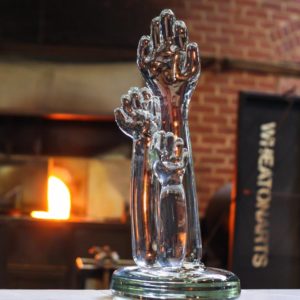In South Jersey’s Cumberland County, nothing gets people more riled up than high school football. Cumberland boasts the oldest rivalry in New Jersey, and one of the oldest in the country—between Millville and Vineland, its two largest high schools—that culminates in an annual Thanksgiving Day showdown that began in 1894.

Prefer the audio version of this story? Listen to this article on CitizenCast below:

The football wins are nearly evenly split between the Vineland Fighting Clan and Millville Thunderbolts. But there’s another, smaller, Cumberland County town that won bragging rights last November: Shiloh, population 500. That win wasn’t for football, though. It was for something arguably even more important: Turnout Trophy.

In the runup to the midterms last November, Cumberland County election officials were brainstorming ways to increase the historically low turnout for off-year elections, when talk turned (as usual) to football. County Clerk Celeste Riley says a lightbulb went off.
“Everyone is always so excited about football,” Riley says. “They love to compete. This was a way of using this concept and having friendly competition about voting.”
Launched a couple months before the November election, the Turnout Trophy competition pitted the 14 towns in Cumberland against each other in a race for to have the highest percentage of residents who went to the polls. Shiloh saw a turnout of nearly 63 percent—nine percent over its 2014 turnout. Vineland—which also beat Millville on Thanksgiving—had the highest increase of every town, 14 percent, for 56 percent turnout. Of the 14 Cumberland County towns, just one fell below the 40 percent national average for midterm turnout.
Can you imagine the door knocking you’d get with fierce contest between two local election captains trying to beat each other for the trophy? Just the conversations alone would boost our civic participation.
Overall, turnout was 46 percent, 13 points more than in 2014. That contributed to New Jersey’s more than 20 percent increase in voter turnout statewide, the second highest gain in the country. (The state last year also initiated a new vote-by-mail process, which has been shown to boost turnout.)
![]()
In Shiloh, Mayor Brad Campbell says getting residents engaged was simple: He advertised the turnout trophy at the town’s offices, and that excitement was spread by word-of-mouth at Shiloh’s single corner store and post office.
“Shiloh’s a very proud community and we don’t take it lightly,” he says. “We’re happy to be out there and show we care. Everybody should care about their community and with a little more input, maybe things would be a lot better.”
Shiloh is, of course, smaller than most Philly blocks. But if there’s anything here Philadelphians can relate to it’s our love of competition (and, of course, sports). Perhaps a friendly intra-city competition of the kind in Cumberland County would help boost turnout here, as well.
“Shiloh’s a very proud community and we don’t take it lightly,” Mayor Campbell says. “We’re happy to be out there and show we care. Everybody should care about their community and with a little more input, maybe things would be a lot better.”
In November, 51 percent of registered voters in Philly went to the polls—a jump from 2014’s 36 percent, but still a poor showing in a time and place when voting matters more than ever. In November, after all, our ballots chose the Governor and state and federal legislators; this May (and then November), we’ll choose our next Mayor, City Council, Sheriff, Election Commissioners and many more.
![]()
There is some precedent for a turnout competition here: Last November, Central High School history teacher Thomas Quinn led the drive to register eligible high school seniors, initiating a friendly contest among area schools. That helped increase turnout among young people by 111 percent citywide. This spring, he’s challenged his counterpart at rival Northeast High School.
What if Temple and Penn challenged each other to bring the most students to the polls in May? Or how about a neighborhood contest: Chestnut Hill vs Mayfair vs Packer Park, perhaps. Or even more local, with ward vs. ward: Can you imagine the door knocking you’d get with fierce contest between two local election captains trying to beat each other for the trophy? Just the conversations alone would boost our civic participation.
![]()
“Our elected officials that we send to the state, the ones who set up the budget, are the people who need your participation. If you’re not participating, they’re not really listening to you,” Riley notes.
In Cumberland Country, what started as a lighthearted competition has led more generally to more interest in local politics. Campbell said the trophy, which was made by local blown glass company Wheaton Arts, is kept at Shiloh’s high school, where it has proven to be a great conversation starter—including about what Shiloh citizens can do to win again next year.
“Everyone should be involved,” he says. “You don’t have to wait for anything, you can go out and do it. I think that walking past the trophy can get someone involved in government or voting and can get them active.”
This article is supported by the Solutions Journalism Network, a nonprofit dedicated to rigorous and compelling reporting about responses to social problems.
Photo via Element5









